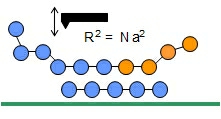recent projects
SFB Transregio 102: projekt A1 Effects of topological constraints in polymer melts on crystallization and structure formation
Summary:
In this project we want to study the effect of the constraints exerted by the topologi-cal structure and dynamics of the entangled polymer melt on the crystallization and on the sem-icrystalline morphology of polymers. Using a number of model materials we will investigate the process of structure formation and the resulting semicrystalline materials in a systematic way by combining small angle x-ray scattering and spin diffusion NMR (structure formation), optical microscopy (crystallization kinetics), DSC (thermodynamics), and rheology and solid state NMR (molecular dynamics). Special emphasis will be given to investigating the properties of the amorphous fraction of the semicrystalline materials as the effects of constraints should show up most clearly there.
SFB/Transregio 102: Teilprojekt B3 Substrate-induced molecular order and nucleation in thin films of semicrystal-line polymers
Summary:
The subject of the proposal is the investigation of the interface between a crystalline solid and the melt of a crystallisable polymer. Such interfaces play a decisive role during the processes of heterogeneous nucleation and of crystal growth. We will study thin films of crystal-lisable polymers on substrates, which give rise to epitaxial crystallization as model systems. Experiments will be performed in the melt state, during and after crystallization combining struc-tural analysis via AFM and X-ray scattering. These will give complementary information about morphology on a mesoscopic scale and about crystal structure on a molecular scale.
DFG project - Synthesis and Bond-Dynamics of Pseudo-BlockCopolymers
Summary
The project deals with the synthesis, structure formation and mechanical properties of microphase separated pseudo block copolymers. In contrast to ‘normal’ block copolymers in which immiscible blocks are connected via a covalent bond, we will study systems in which the blocks are connected via hydrogen bonds. Such self associating polymers are interesting as materials with self healing properties. Several polymer systems with different glass transition temperatures, miscibility and molecular weight will be investigated. Dynamic mechanical measurements and small angle x-ray scattering will be used to gain information on the mobility of individual polymer chains and the nature of the hydrogen-bonds acting as molecular “glue” between them.
DFG Project in SPP 1355 „Elementary Processes of Organic Photovoltaics”
Organic Solar Cells from Optimized Self-Assembling Block Copolymers with Controlled Nanoscale Morphology
Summary
The project is a joint effort between Macromolecular Chemistry, Physical Chemistry and Experimental Physics in which three groups bring in complementary expertise from different fields such as synthesis, morphological studies, and device physics. The aim of the project is to design, synthesize, and study fully functionalised self-assembling block copolymers to realize and optimize nanostructured bulk heterojunction solar cells. Block copolymers guarantee desired stable nanoscale morphologies throughout the bulk, keeping the domain size in the same range as exciton diffusion lengths. Novel block copolymers will be synthesized designed to optimize the efficiency of photoinduced charge separation and charge transport in a system with a well controlled stable nanostructure based on microphase separation and crystallization. Structure formation processes will be studied in detail in order to gain the necessary understanding for a rational design of suitable processing steps for film formation. The electro-optical properties of the resulting materials will be investigated with the aim to understand the physics of solar cell devices based on the materials developed within the project.


